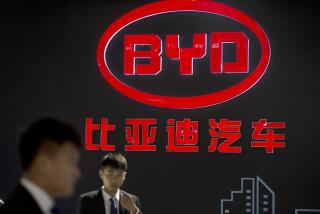Japan Shaving the Trade Gap in Auto Parts : Exports: Japanese car makers are buying more American-made components, but Ford and other U.S. firms say it isn’t enough.
- Share via
DETROIT — When Toyota Motor Corp. held its first meeting for U.S. automobile parts suppliers in 1991, the gathering was in Japan. It attracted just 53 companies.
This year it will be in the United States for the first time, and attendance is expected to double. About 100 suppliers hoping to crack the tough Japanese market are scheduled to attend the meeting beginning today in Long Beach.
The journey of Toyota officials from Tokyo to California to meet with U.S. auto parts makers speaks volumes about the state of the automotive industry, where competition is cutthroat and trade disputes abound.
One of the most contentious trade issues is that of auto parts purchasing. Japanese auto makers are under great pressure to increase their buying from U.S. suppliers to ease the $10-billion parts trade deficit with Japan.
In January, 1992--during President Bush’s ill-fated trade mission to Tokyo--the Japanese set a voluntary goal of increasing their purchases of American auto parts to $19 billion by 1994 (from $9 billion in 1990). Now, some Big Three executives say, the Japanese are dragging their feet.
Ford Motor Co. Chairman Harold A. Poling said earlier this year that the Japanese might not make good on their pledge. U.S. Trade Representative Mickey Kantor pointedly warned Japanese officials last month against backing away from the commitment.
Most industry experts, nonetheless, say the Japanese have made significant progress.
The latest figures available show that Japanese purchases from U.S. suppliers for production both in Japan and at Japanese auto plants in the United States hit about $13 billion last year, representing a 44% increase in two years.
“There is no question they are aggressively pursuing American suppliers, both domestically and for imports,” said David Cole, director of the University of Michigan’s Office for the Study of Automotive Transportation.
The Japanese manufacturers are doing so in a difficult environment. Their car sales are slumping, their own economy is in a tailspin and the yen has appreciated greatly against the dollar, so it is more difficult to sell Japanese cars in the United States. But Toyota, Honda, Nissan and other Japanese auto makers say that such problems will not deter them from their long-term goals.
“We are not backing away,” said John McCandless, speaking for Toyota Motor Sales U.S.A. in Detroit.
Toyota set a goal of purchasing $3.8 billion from U.S. suppliers in the 12 months that ended March 31 for its U.S. and Japanese operations.
The company says it has exceeded that figure, and will report U.S. parts purchases in excess of $4 billion at the supplier meeting.
According to company officials, Toyota is on schedule to meet its 1994 goal of buying $5.2 billion in U.S. auto parts.
Some critics question the importance of such accomplishments. They point out that the figures include purchases from Japanese-owned companies operating in the United States. They also argue that the parts deficit may not shrink, because most of the purchases are for the Japanese manufacturers’ U.S. plants--not for export to Japan.
The Japanese car makers are sensitive about the politically charged issue, which last year prompted congressional hearings. The question could arise again in a few weeks, when the Commerce Department’s auto parts advisory committee delivers a status report on the Japanese efforts.
Indeed, the car makers’ ability in coming months to meet the 1994 goals assumes a 50% increase in production at their U.S. plants, according to William Duncan, general director of the Japan Automobile Manufacturers Assn.’s Washington office.
And that will be hard to accomplish. The Japanese share of the U.S. car and truck market slipped 1% last year and has continued to slide in 1993.
Still, the improved quality of U.S.-made parts and the expanding presence of the Japanese auto makers in the United States may help the firms meet their commitments.
For instance, Toyota now tests supplier parts at its technical center in Ann Arbor, Mich., instead of sending them to Japan for testing. Such processes have spurred the development of “designed-in parts”--components engineered by the supplier--thereby holding down the car maker’s costs and guaranteeing the supplier business.
The efforts have shown some results for Toyota. The company boosted its base of U.S. suppliers to 391 last year from 303 in 1991. Its plant in Georgetown, Ky.--which produces the Toyota Camry--relies on 174 U.S. suppliers for 1,350 different parts and draws 85% of its steel from U.S. sources.
But critics note that the Japanese market itself is still largely closed to U.S. suppliers. Only 25% of Toyota’s purchases of U.S. parts is destined for the Japanese market.
The Japanese beg for patience, saying their business is built on mutual trust that takes a long time to develop.
Supplier meetings such as the one in Long Beach are designed to build those long-term relationships. Last year’s meeting resulted in 39 new supplier contracts, according to Toyota spokesman Steven J. Brodsky.
Made in America Toyota, the biggest car maker in Japan, has steadily boosted its purchases of parts and materials in the United States. Toyota purchases of U.S. parts (in billions of dollars) For fiscal years ending March 31 of the following year
1988 1989 1990 1991 1992* 1994** Parts purchased for $0.3 $0.5 $0.7 $0.8 $1.0 $1.46 export to Japan Parts purchased for $0.8 $1.4 $1.9 $2.1 $3.0 $3.82 Toyota’s U.S. production Total $5.28
* projected ** planned Source: Toyota






